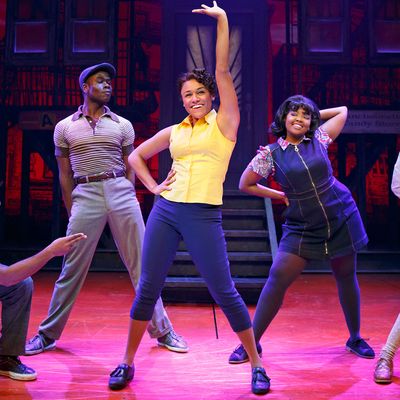
There’s a good reason Broadway musicals traditionally leave the gangsters backstage. Except when handled with the greatest skill — as in, say, Guys and Dolls — stories that include mob hits or street violence or sadistic shakedowns are always going to conflict with the chipper razzmatazz that characterizes the form. Perhaps the authors of A Bronx Tale, which opened tonight at the Longacre, felt they could finesse that problem by splitting the difference between very dark works like West Side Story and very silly ones like Bullets Over Broadway. But no: For all the craft and polish applied, this musical winds up right in the middle of the wrong place. It’s an unmoving target.
You can see how it got there. The charming 1989 play on which it’s based was a one-man affair, written and performed by Chazz Palminteri. In it he played Calogero Lorenzo Alfredo Romano Anello, a boy growing up in the 1960s in the heavily Italian Belmont neighborhood of the Bronx. The son of a humble but principled bus driver and his homemaker wife, Calogero becomes enamored of Sonny LoSpecchio, the local mob boss, after seeing him shoot a guy on the street; when Calogero refuses to rat, Sonny takes him under his wing. The play, like the 1993 movie and now the musical, proceeded from the conflict of morality reflected in the paired father figures. (LoSpecchio means “the mirror.”) Is an honest life worth leading if it’s miserable? Is a happy life sustainable if it’s dishonest? These are the questions the boy has to ask and answer. But Palminteri didn’t just play the boy in the stage version: He played everyone. And the fact that the material was largely autobiographical (Palminteri’s given name is Calogero) meant that his portraits and thus his questions rang especially true.
Nothing rings true in the musical, right from an opening number (“Belmont Avenue”) that, following the manual, introduces the neighborhood and its characters as a happy collection of pockmarked goombahs and sauce-making nonnas. The singular point-of-view of the one-man play is of course split up in a multi-actor version: Not only Calogero but also his parents and Sonny and the gangsters and everyone else get to speak for themselves. What a first-person monologue could knit together and rationalize, third-person dialogue, even if framed by Calogero’s narration, lays bare for unraveling. Played out in live scenes rather than in retrospective, the same plot thus seems like less of an impressionistic fable than a stab at realism: a stab that misses and misses and misses. The basic story is already a bit rich for naturalism, with its dueling dads and bump-offs and crap games, but pile on top of them an interracial romance, some Molotov cocktails, and a climactic assassination, and — hey, nonna, your sauce is boiling over.
The point-of-view problem, inevitable in dramatization, is only exacerbated by musicalization; not only do the characters speak for themselves here, they sing for themselves. The teenaged boys doo-wop, the black characters rock and roll, and even Sonny has a clutch of songs to flesh out his motivations and philosophy. (One is a weird tribute to “Nicky” Machiavelli.) These songs are all as professional and tuneful as you would expect from the team of Alan Menken and Glenn Slater, who also wrote The Little Mermaid and Sister Act together. They do perfectly well what songs are supposed to do in standard commercial musicals: They set up the conflicts, establish the milieu, express the longings, and forward the plot. But in doing so they normalize material that should not be normalized; as expressed in delightful music, the motivations of a gangster come to seem like excuses. There is something profoundly immoral about easy-listening thugs.
The other side of that coin is that the songs sound like they could have been written for The Little Mermaid or Sister Act or any number of other middle-of-the-road musicals. Their bright, textureless style is matched by that of the production, which was co-directed —somehow — by Jerry Zaks (who staged a 2007 Broadway revival of the play) and Robert De Niro (who made and starred in the film). One thing you can say for the unlikely pair is that they run a tight ship: Despite the addition of about 19 musical numbers, they bring the thing in at a swift two hours, the same length as the movie. (Toward the end, with every scrap of connective tissue removed, events collide into each other like bone hitting bone.) One thing you can’t say is that Zaks and De Niro give the show a distinctive profile. Among the presumably inadvertent Easter eggs I noticed were references to Newsies, Hairspray, Guys and Dolls, Jersey Boys, and, of course, West Side Story. A Bronx Tale will remind you of all of those, and more; it just won’t remind you of itself.
That’s a shame; the musical is handsome and reasonably well performed, especially by Bobby Conte Thornton as Calogero and Nick Cordero as Sonny. And it still has, in précis, that timely and timeless set of concerns. In a corrupt society, is the working man “a sucker,” as Sonny maintains? How do we make moral sense of the good qualities of bad people — and vice versa? That A Bronx Tale, as a musical, never answers these questions is fair enough; that it lacks the subtlety to raise them seriously is very nearly a crime.
A Bronx Tale is at the Longacre Theatre.

